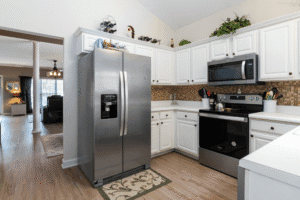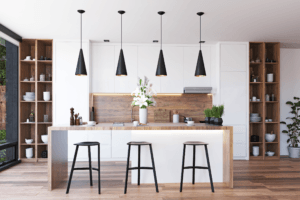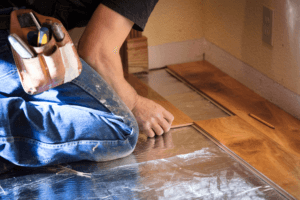Cabinet installation is a crucial element of any home improvement project, whether you’re renovating your kitchen, bathroom, or another area of your home. The cost of this project can vary significantly based on several factors, including the type of cabinetry, the complexity of the installation, and your location.
Understanding the different components that contribute to the overall price of cabinet installation will help you budget effectively for your project. This guide will walk you through everything you need to know about cabinet installation costs, from basic options to custom installations.
Factors That Influence Cabinet Installation Costs
Cabinet installation prices are influenced by various factors, and understanding these can give you a better idea of how to plan for your upcoming home improvement project. Here are some of the most important factors to consider when estimating cabinet installation costs.
1. Type of Cabinetry: Stock, Semi-Custom, and Custom Cabinets
The type of cabinets you choose has a significant impact on the cost of installation. Cabinets come in three main categories: stock, semi-custom, and custom.
- Stock Cabinets: These are pre-manufactured and ready for installation. Stock cabinets are typically the least expensive option. They come in standard sizes, finishes, and materials, which limits your design options. The cost of installing stock cabinets can range from $100 to $300 per linear foot, depending on the brand and style.
- Semi-Custom Cabinets: These offer more flexibility in design and dimensions. You can choose from a wider range of finishes and add some custom features, such as deeper drawers or unique hardware. Semi-custom cabinets tend to be more expensive than stock options, with costs ranging from $200 to $600 per linear foot.
- Custom Cabinets: As the name suggests, custom cabinets are designed and built specifically for your space. They offer complete flexibility in design, materials, finishes, and dimensions. Custom cabinetry is the most expensive option, with costs typically ranging from $500 to $1,200 or more per linear foot. However, the result is a one-of-a-kind piece that perfectly suits your space and style.
2. Materials and Finishes
The materials and finishes you select for your cabinets will also affect the installation cost. Common materials used for cabinetry include:
- Wood: Hardwood is a popular choice for its durability and aesthetic appeal. Common types of wood used for cabinets include oak, cherry, maple, and walnut. The more premium the wood, the higher the price.
- Plywood: Often used for the cabinet boxes, plywood is durable and cost-effective. However, the quality of plywood varies, which can influence the cost.
- Particleboard and MDF: These are less expensive materials often used in stock and semi-custom cabinets. They are less durable but still offer good quality for the price.
The finish you choose—whether it’s painted, stained, or left natural—also affects the price. Painted cabinets, particularly those with a smooth finish or custom color, can increase the overall cost due to the labor and materials required.
3. Size and Layout of the Room
The size and layout of the room where the cabinets will be installed play a significant role in determining installation costs. Larger kitchens or bathrooms with complex layouts will require more labor and materials, resulting in a higher cost. A larger kitchen with a more intricate design may require additional cabinets, drawers, or shelves, all of which contribute to higher costs.
Additionally, spaces with difficult-to-reach areas or unconventional layouts may require additional custom work, which can increase labor time and costs. This is especially true for custom kitchen remodels where a unique, tailored approach is needed.
4. Complexity of the Installation
Cabinet installation complexity can vary greatly depending on the design and features you choose. For example:
- Standard Installations: If you’re replacing existing cabinets with new ones and the measurements are the same, the installation process is relatively straightforward.
- Complex Installations: If your project involves installing cabinets in areas that require special features, such as pull-out drawers, lazy Susans, or crown molding, the cost will increase. Additionally, projects involving complicated features, such as integrating appliances or customizing cabinet sizes to fit specific spaces, can add to the complexity.
More intricate designs require additional expertise and time, which will be reflected in the final price.

5. Labor Costs and Professional Fees
The labor cost is one of the most significant factors contributing to the price of cabinet installation. Hiring a skilled cabinet installer or general contractor with experience in cabinetry ensures a high-quality finish. Labor rates can vary depending on your location, with larger cities like San Diego, Philadelphia, and Houston typically having higher rates due to the increased demand for skilled labor.
On average, cabinet installation labor costs can range from $40 to $100 per hour. The total labor cost will depend on the size and complexity of your project. For example, a straightforward installation may take 8-12 hours, while a more complex project could take several days.
If you are hiring a general contractor for the job, their fee will include labor costs and the cost of managing the project, which can add an additional 10-20% to the overall price.
Cost Breakdown: Stock, Semi-Custom, and Custom Cabinet Installation
To give you a better understanding of the costs involved, here’s a breakdown of the average prices for cabinet installation, based on different types of cabinetry:
- Stock Cabinets: $100 – $300 per linear foot
- Semi-Custom Cabinets: $200 – $600 per linear foot
- Custom Cabinets: $500 – $1,200 per linear foot
If you need help calculating the cost of your cabinet installation, consider the following:
- Measure the space where your cabinets will be installed.
- Determine the number of linear feet of cabinetry needed.
- Multiply the linear feet by the price range for the type of cabinets you’re considering (stock, semi-custom, or custom).
This will give you an estimate of the total cost for cabinetry alone, excluding labor and other factors.
Additional Costs to Consider
While cabinet installation is the primary expense, there are additional costs to account for in a kitchen or bathroom remodel. These may include:
- Countertop Installation: Countertops are often installed in conjunction with cabinets, and their cost can vary depending on the material you choose. Granite, marble, and quartz countertops can be expensive, while laminate options tend to be more affordable.
- Cabinet Hardware: Handles, knobs, and pulls are small but important additions to your cabinets. The cost of hardware can vary depending on the style and material, ranging from $1 to $50 per piece.
- Demolition and Removal: If you’re replacing old cabinets, the cost of removing the existing cabinets and disposing of them should be factored into your budget. Demolition costs can range from $200 to $500, depending on the size of the space and the amount of work required.
How to Save on Cabinet Installation Costs
While cabinet installation can be expensive, there are several ways to save on costs:
- Consider Stock or Semi-Custom Cabinets: If you’re working with a tight budget, stock or semi-custom cabinets can be an excellent choice. They offer a good balance of quality and affordability compared to custom options.
- Do-It-Yourself: If you’re handy and have experience with basic carpentry, you may be able to install the cabinets yourself. However, this is a big undertaking and requires expertise to avoid costly mistakes.
- Shop Around: Get quotes from multiple installers to ensure you’re getting a competitive price. Don’t be afraid to negotiate the price or ask for discounts on bulk orders.
- Consider Refacing Existing Cabinets: If the structure of your cabinets is in good condition, consider cabinet refacing as a more affordable option. Refacing involves replacing the cabinet doors and drawers while leaving the cabinet boxes intact.
Return on Investment: Are Cabinets Worth the Cost?
Cabinet installation is an investment in your home, and it can significantly enhance the value of your property. Whether you’re installing cabinets in your kitchen, bathroom, or any other room, new or upgraded cabinets can make a big difference in both functionality and aesthetics.
In terms of return on investment, kitchen remodels typically offer one of the highest returns, with a well-executed project boosting your home’s resale value. The national average for a kitchen remodel return on investment is between 60% and 80%. Custom cabinetry, while more expensive, can add even greater value to your home, particularly in high-end properties.
Understanding Cabinet Installation Costs: Factors and Budgeting TipsConclusion
Cabinet installation costs can vary greatly depending on the type of cabinetry, the size and complexity of the project, and the labor involved. While it can be a significant investment, high-quality cabinetry can enhance both the functionality and aesthetic appeal of your home. Whether you’re opting for stock, semi-custom, or custom cabinets, it’s essential to carefully consider your budget and the factors that influence the overall price.
By understanding the cost components involved, you can make an informed decision and ensure that your cabinet installation project is a success. If you’re looking for expert guidance and professional installation services don’t hesitate to reach out for a consultation.



